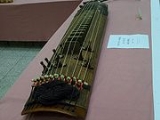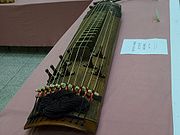
Geomungo
Encyclopedia
The geomungo or hyeongeum (literally "black zither", also spelled hyongum or hyŏn'gŭm) is a traditional Korea
n stringed musical instrument
of the zither
family of instruments with both bridges and fret
s. Scholars believe that the name refers to Goguryeo
and translates to "Goguryeo zither" or that it refers to the colour and translates to "black crane zither".
 The instrument originated circa the 4th century (see Anak Tomb No.3
The instrument originated circa the 4th century (see Anak Tomb No.3
infra) through the 7th century from the kingdom of Goguryeo, the northernmost of the Three Kingdoms of Korea
, although the instrument can be traced back to the 4th century.
According to the Samguk Sagi
(Chronicles of the Three Kingdoms), written in 1145, the geomungo was invented by prime minister Wang San-ak
by using the form of the ancient Chinese instrument guqin
(also called chilhyeongeum, literally "seven-string zither"). After his death, the instrument was passed down to Ok Bogo, Son Myeong-deuk, Gwi Geum, An Jang, Cheong Jang, and Geuk Jong, while being widely spread over the kingdom.
Archetype of the instrument is painted in Goguryeo
tombs. They are found in the tomb of Muyongchong and Anak Tomb No.3
.
wood and the back plate is made of hard chestnut
wood. Its six strings, which are made of twisted silk
passed through its back plate. The pick is made from bamboo sticks in the size of regular household pencil.
stick called suldae, which is held between the index and middle fingers of the right hand, while the left hand presses on the strings to produces various pitches
. The most typical tuning
of the open strings for the traditional Korean music is D#/Eb, G#/Ab, C, A#/Bb, A#/Bb, and A#/Bb an octave
lower than the central tone. The instrument is played in traditional Korean court music and the folk styles of sanjo
and sinawi
.
Due to its characteristically percussive sound and vigorous playing technique it is thought of as a more "masculine" instrument than the 12-string gayageum
(another Korean zither); both instruments, however, are played by both male and female performers.
The Korean-born, U.S. resident geomungo performer and composer Jin Hi Kim
plays a custom-made electric geomungo in addition to the regular instrument.photo
Korea
Korea ) is an East Asian geographic region that is currently divided into two separate sovereign states — North Korea and South Korea. Located on the Korean Peninsula, Korea is bordered by the People's Republic of China to the northwest, Russia to the northeast, and is separated from Japan to the...
n stringed musical instrument
Musical instrument
A musical instrument is a device created or adapted for the purpose of making musical sounds. In principle, any object that produces sound can serve as a musical instrument—it is through purpose that the object becomes a musical instrument. The history of musical instruments dates back to the...
of the zither
Zither
The zither is a musical string instrument, most commonly found in Slovenia, Austria, Hungary citera, northwestern Croatia, the southern regions of Germany, alpine Europe and East Asian cultures, including China...
family of instruments with both bridges and fret
Fret
A fret is a raised portion on the neck of a stringed instrument, that extends generally across the full width of the neck. On most modern western instruments, frets are metal strips inserted into the fingerboard...
s. Scholars believe that the name refers to Goguryeo
Goguryeo
Goguryeo or Koguryŏ was an ancient Korean kingdom located in present day northern and central parts of the Korean Peninsula, southern Manchuria, and southern Russian Maritime province....
and translates to "Goguryeo zither" or that it refers to the colour and translates to "black crane zither".
History

Anak Tomb No.3
Anak Tomb No. 3 is a chamber tomb of Goguryeo located in Anak, North Korea. It is known for mural paintings and an epitaph. It is part of the Complex of Goguryeo Tombs....
infra) through the 7th century from the kingdom of Goguryeo, the northernmost of the Three Kingdoms of Korea
Three Kingdoms of Korea
The Three Kingdoms of Korea refer to the ancient Korean kingdoms of Goguryeo, Baekje and Silla, which dominated the Korean peninsula and parts of Manchuria for much of the 1st millennium...
, although the instrument can be traced back to the 4th century.
According to the Samguk Sagi
Samguk Sagi
Samguk Sagi is a historical record of the Three Kingdoms of Korea: Goguryeo, Baekje and Silla. The Samguk Sagi is written in Classical Chinese and its compilation was ordered by Goryeo's King Injong Samguk Sagi (History of the Three Kingdoms) is a historical record of the Three Kingdoms of...
(Chronicles of the Three Kingdoms), written in 1145, the geomungo was invented by prime minister Wang San-ak
Wang San-ak
Wang San-ak was the Prime Minister of Goguryeo during the reign of King Yangwon.According to the Samguk Sagi, written in 1145, the geomungo was invented by him by using the form of the ancient Chinese instrument guqin...
by using the form of the ancient Chinese instrument guqin
Guqin
The guqin is the modern name for a plucked seven-string Chinese musical instrument of the zither family...
(also called chilhyeongeum, literally "seven-string zither"). After his death, the instrument was passed down to Ok Bogo, Son Myeong-deuk, Gwi Geum, An Jang, Cheong Jang, and Geuk Jong, while being widely spread over the kingdom.
Archetype of the instrument is painted in Goguryeo
Goguryeo
Goguryeo or Koguryŏ was an ancient Korean kingdom located in present day northern and central parts of the Korean Peninsula, southern Manchuria, and southern Russian Maritime province....
tombs. They are found in the tomb of Muyongchong and Anak Tomb No.3
Anak Tomb No.3
Anak Tomb No. 3 is a chamber tomb of Goguryeo located in Anak, North Korea. It is known for mural paintings and an epitaph. It is part of the Complex of Goguryeo Tombs....
.
Construction
The geomungo is approximately 162 cm long and 23 cm wide (63.75 inches long, 9 inches wide), and has movable bridges called Anjok and 16 convex frets. It has a hollow body where the front plate of the instrument is made of paulowniaPaulownia
Paulownia is a genus of from 6 to 17 species of plants in the monogeneric family Paulowniaceae, related to and sometimes included in the Scrophulariaceae. They are native to much of China, south to northern Laos and Vietnam, and long cultivated elsewhere in eastern Asia, notably in Japan and Korea...
wood and the back plate is made of hard chestnut
Chestnut
Chestnut , some species called chinkapin or chinquapin, is a genus of eight or nine species of deciduous trees and shrubs in the beech family Fagaceae, native to temperate regions of the Northern Hemisphere. The name also refers to the edible nuts they produce.-Species:The chestnut belongs to the...
wood. Its six strings, which are made of twisted silk
Silk
Silk is a natural protein fiber, some forms of which can be woven into textiles. The best-known type of silk is obtained from the cocoons of the larvae of the mulberry silkworm Bombyx mori reared in captivity...
passed through its back plate. The pick is made from bamboo sticks in the size of regular household pencil.
Playing
The geomungo is generally played while seated on the floor. The strings are plucked with a short bambooBamboo
Bamboo is a group of perennial evergreens in the true grass family Poaceae, subfamily Bambusoideae, tribe Bambuseae. Giant bamboos are the largest members of the grass family....
stick called suldae, which is held between the index and middle fingers of the right hand, while the left hand presses on the strings to produces various pitches
Pitch (music)
Pitch is an auditory perceptual property that allows the ordering of sounds on a frequency-related scale.Pitches are compared as "higher" and "lower" in the sense associated with musical melodies,...
. The most typical tuning
Musical tuning
In music, there are two common meanings for tuning:* Tuning practice, the act of tuning an instrument or voice.* Tuning systems, the various systems of pitches used to tune an instrument, and their theoretical bases.-Tuning practice:...
of the open strings for the traditional Korean music is D#/Eb, G#/Ab, C, A#/Bb, A#/Bb, and A#/Bb an octave
Octave
In music, an octave is the interval between one musical pitch and another with half or double its frequency. The octave relationship is a natural phenomenon that has been referred to as the "basic miracle of music", the use of which is "common in most musical systems"...
lower than the central tone. The instrument is played in traditional Korean court music and the folk styles of sanjo
Sanjo (music)
Sanjo, literally meaning 'scattered melodies' and is a style of traditional Korean music, involving an instrumental solo accompanied by drumming on the janggu, an hourglass-shaped drum...
and sinawi
Sinawi
Sinawi, sometimes spelled shinawi, is a traditional form of Korean music. It is performed improvisationally by a musical ensemble, and traditionally accompanies the rites of Korean shamanism. The style first emerged in the Chungcheong and Jeolla provinces, but is now widespread...
.
Due to its characteristically percussive sound and vigorous playing technique it is thought of as a more "masculine" instrument than the 12-string gayageum
Gayageum
The gayageum or kayagum is a traditional Korean zither-like string instrument, with 12 strings, although more recently variants have been constructed with 21 or other numbers of strings. It is probably the best known traditional Korean musical instrument...
(another Korean zither); both instruments, however, are played by both male and female performers.
The Korean-born, U.S. resident geomungo performer and composer Jin Hi Kim
Jin Hi Kim
Kim Jin-Hi is a geomungo player and composer.She is known for introducing the geomungo to the wider world through her contemporary chamber and orchestral compositions and large-scale multimedia pieces, as well as her extensive work in avant-garde and cross-cultural free...
plays a custom-made electric geomungo in addition to the regular instrument.photo
See also
- Traditional Korean musical instrumentsTraditional Korean musical instrumentsTraditional Korean musical instruments comprise a wide range of string, wind, and percussion instruments.-String:Korean string instruments include those that are plucked, bowed, and struck...
- Korean musicKorean musicTraditional Korean music includes both the folk, vocal, religious and ritual music styles of the Korean people. Korean music, along with arts, painting, and sculpture has been practiced since prehistoric times....
- List of Korea-related topics

